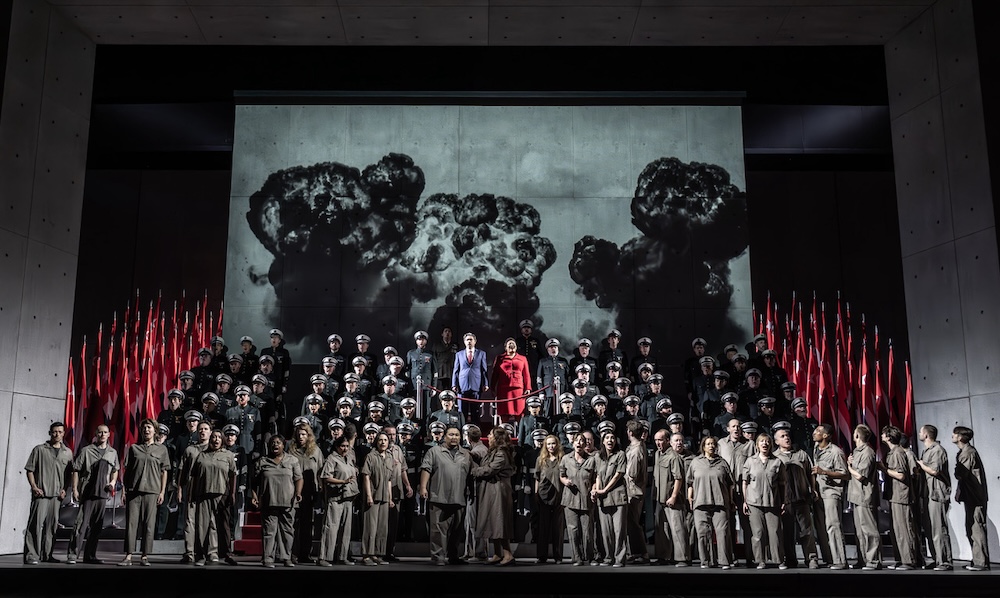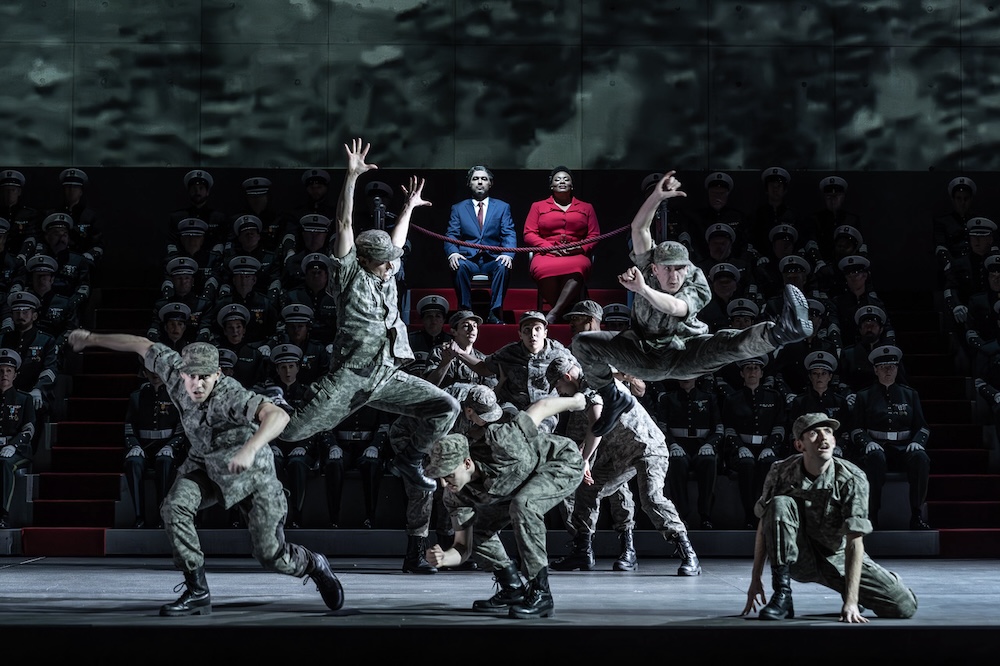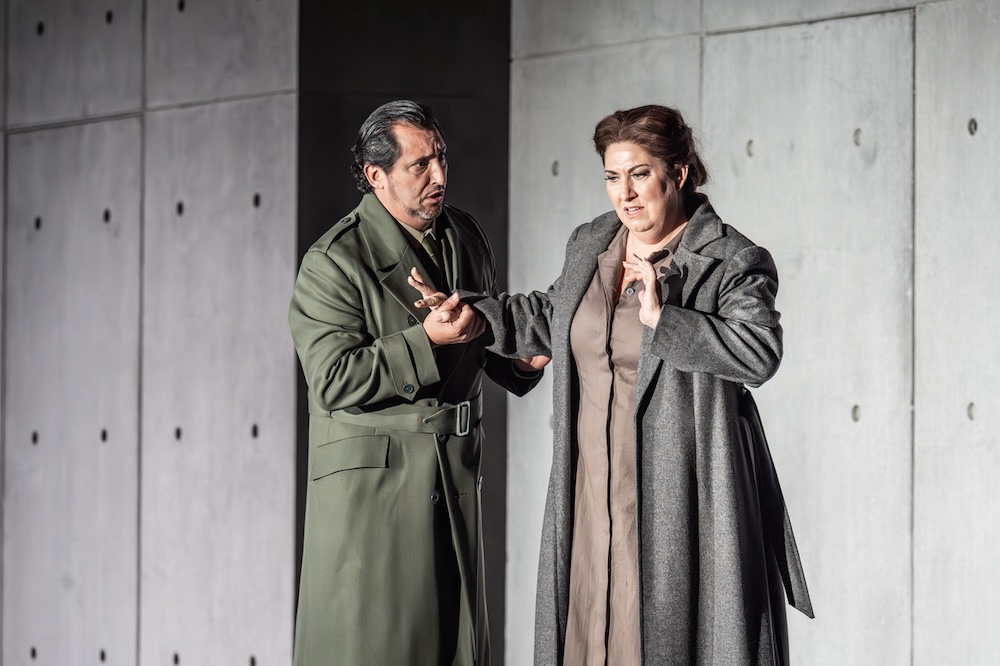An empty stage enclosing grey walls of a concrete bunker. This is the initial impression we have of Robert Carsen’s Aida, presented at the Royal Opera House in a first revival by Gilles Rico. The cheerless staging does not so much convey a barren Egyptian desert but suggests, in its non-specific anywhere locale, an unnamed modern-day totalitarian state, an amalgamation comprising three-parts United States, Russia and China. Spectacle is decidedly passé in this radical reimagining of North Africa where the presence of palm trees, pyramids and Pharaohs are abandoned for a vast mausoleum-like structure, its cavernous space, where the sun never shines, conjuring an oppressive military dictatorship that feels troublingly contemporary with today’s geo-political parallels.

This is clearly not just a love story with a tragic ending, since Carsen is more interested in sharpening his directorial pencil on abuses of power, mirroring Verdi’s anti-militarist views to make this particular Aida a savage denunciation of war. While that narrative is underlined in thick marker pen, Carsen is not blind to themes of homeland and patriotism. In the souvenir programme he explains that he is struck by the frequency of three words — guerra, morte, patria — which recur in the libretto. He claims to have focused on the opera’s conflict between personal feeling and patriotism and the way individuals are “caught up and often destroyed by the forces of state and religion”. These facets all contribute to a multi-layered interpretation, but it’s one not without a few problems.
Chief amongst these is the challenge in creating a believable chemistry between the central characters, especially when key individuals are often physically at some remove from another. Coupled with the sheer scale of Miriam Buether’s monumental set, emotional involvement between the lovers is somewhat compromised. But by the Nile scene and Act 4’s entombment amongst dozens of deadly missiles, relationships have begun to develop. Yet why is Aida, the captured Ethiopian princess, in love with the warrior Radamès, captain of the Egyptian army? And for that matter why is Amneris also in love with him? I guess it’s not important, since they are largely ciphers to underline the notion of their being at the mercy of the political machinations of the state.
And this is an authoritarian state of blatant posturing, of ostentatious ceremony and, of course, triumphal marching, ideas which Carsen repeatedly rams home with a near-flawless attempt at parade ground precision with soldiers in combat fatigues or swanky uniforms as if they were Westpoint graduates. It’s quite a sight to see their regimental movements, but there are only so many times one can enjoy watching men salute, fold flags or carry coffins. At least Verdi’s dance sequence following the Triumphal March (celebrating the Egyptians victory over the Ethiopian army) was beautifully choreographed by Rebecca Howell. Her leaping squaddies cleverly caught the artistry of ballet and the savagery of unarmed fighting, while video projections of past bombing raids (Vietnam or Iraq?) portrayed death and destruction.

Anyone disenchanted by the staging’s fifty shades of grey will not be disappointed by the singing from a strong international cast where tonal colour is much in evidence. Most striking is the weapons-grade tenor of Jorge de León (a later replacement for Riccardo Massi) whose Radamès has bags of stamina and ringing high notes, even if his opening ‘Celeste Aida’ has more determination than subtlety. As his doomed lover Aida, Anna Pirozzi (lead photo) is no shrinking violet, and while she can’t match her beloved for decibels, hers is an affecting and passionate portrayal with the most delicate upper register. When singing of her homeland she casts a considerable spell with her controlled phrasing and a heart-rending top C. Her rival Amneris, taken by American mezzo Raehann Bryce-Davis (making her ROH debut) eventually brought a fiery intensity to her jealous rages. She’s clearly a name to watch out for. Elsewhere, Alexander Köpeczi is a thrillingly resonant Ramfis, and Amartuvshin Enkhbat (lead photo) as the prisoner King of Ethiopia gives a commanding performance, whose sonorous tones overshadow George Andguladze’s under powered King of Egypt. Mention too should be made of the wonderfully piano singing of the ROH chorus, most notably at the end of Act 1.

On opening night ensemble between stage and pit was occasionally off kilter, with Daniel Orens (supposedly an established Verdian) not always ensuring security between players and singers. Dynamic variety and elegant woodwind solos couldn’t hide some exaggerated tempo changes which felt more wilful than rehearsed. In time, things will settle. Meanwhile, this Aida is well worth seeing, but don’t expect to see any four-legged creatures from London Zoo.
David Truslove
Aida, Opera in four acts, Libretto by Antonio Ghislanzoni. Music by Guiseppe Verdi
Cast and production staff: Aida – Anna Pirozzi; Radamès – Jorge de Léon; Amneris – Raehann Bryce-Davis; Amonasro – Amartuvshin Enkhbat; Ramfis – Alexander Köpeczi; King of Egypt – George Andguladze; High Priestess – Khayakazi Madlala; Messenger – Andrés Presno; Director – Robert Carsen; Revival Director – Gilles Rico; Conductor – Daniel Orens; Set Designer – Miriam Buether; Costume Designer – Annemarie Woods; Lighting Designers – Robert Carsen and Peter van Praet; Choreographer – Rebecca Howell; Video Designer – Duncan McLean; Orchestra and Chorus of the Royal Opera House.
Royal Opera House, Covent Garden, London, 28 January 2025
Photos: © Marc Brenner/Royal Opera House